Vertically Dynamic Response of an End-Bearing Pile Embedded in a Frozen Saturated Porous Medium under Impact Loading
Abstract
A frozen soil is a multiphase medium composed of solid particles, ice, and water, and the cementation between the solid particles and ice strengthens with a decrease in temperature. Based on the theory of a composite solid-state saturated porous medium, a uniform solution for the vertical vibration of an end-bearing pile in a frozen soil is derived analytically. The axial displacements under impact loading in the time domain are calculated by using the numerical inverse transformation technique. The solution can degenerate into an end-bearing pile in a saturated soil layer as the temperature approaches the freezing point. If the cementation between the solid particles and ice is ignored, the amplitude of the displacement will be overestimated. The numerical results show that temperature has a significant impact on the dynamic responses of the pile due to variation of the ice content and, consequently, of the cementation between solid particles and ice.
1. Introduction
In many high-latitude regions of the world, there are large numbers of permafrost and seasonally frozen soils. When constructing structures in these areas, it is inevitable to encounter the problem of the interaction between the foundation and the frozen soil. Especially in the process of constructing expressways and high-speed railways in permafrost or seasonally frozen areas, pile foundations subject to traffic loadings or impact loadings are extensively used. Therefore, it is necessary to study on the dynamic responses of piles in frozen soil areas. Dynamic characteristics of piles embedded in permafrost involve two key issues: one is the physical and mechanical descriptions of the frozen porous medium, and the other one is the dynamic interaction between the pile and the frozen soil. For the first key problem, the frozen porous medium is considered as consisting of a composite solid skeleton and pores formed by the soil particle, and the pores are full of water and air, in which parts of the water freeze to the ice. Therefore, there are two solid-phase matrices (solid substrate and ice matrix), and generally, there is an interaction between the solid and ice; and the cementation strengthens with the deceasing temperature. In addition, due to the mutual transformation among ice, water, and steam, a complex multiphase structure is formed in the frozen soil. Even if the pores are full of water, the frozen soil is still a three-phase composite of solid-phase, ice phase, and liquid phase with phase changes. Therefore, the mathematical description of the frozen soil was always a complex and difficult problem. In the past decades of research, many scholars have devoted themselves to the study and establishment of various frozen porous media models to describe the physical and mechanical properties of frozen soil and got fruitful achievements [1–5]. However, only a few models are applicable to the analysis of dynamic characteristics of frozen soils. Leclaire et al. established a kinematic model of the frozen saturated porous medium consisting of three phases of soil particles, ice, and water, ignoring the interaction between the solid and the ice phases [6]. Then, an ultrasonic test based on the established frozen porous media model verified the existence of multiple body waves predicted by the model [7]. Carcione et al. further considered the interactions among soil particles and ice and water phases and proposed a more rigorous model called LCAM [8–11]. The second key issue concerns the pile-soil interactions in frozen soils, which focus mainly on frost heave problems [12] and pile-soil contact problems [13] in the existing literature; however, the dynamic interaction between the pile and the frozen soil is seldom considered. There are three analytical methods to describe the dynamic interaction between a pile and soil: the distributed rheological method, the virtual pile method, and the simplified continuum analytical method. The distributed rheological method involves simple and easy calculation, which is of great significance for the evaluation of pile integrity [14–16]. The latter two methods belong to the simplified continuum analysis method. A rigorous three-dimensional continuum solution for the vertical vibration of piles tends to be mathematically difficult when using the analytical method. For engineering convenience, the pile is regarded as a one-dimensional rod that made the problem easier to solve. The virtual pile model originated by Muki and Sternberg [17–24] and the simplified continuum analytical model proposed by Nogami and Novak [25] are used to investigate the dynamic load transfer problem of a one-dimensional elastic rod in the stratum. In recent years, several key applications such as large diameter piles and pipe piles have been realized via the latter method [26–29]. Yang and Pan attempted to carry out a three-dimensional analysis based on Saint-Venant’s principle, which is likely the analytical solution most similar to that from a three-dimensional analysis [30]. However, the theory of a one-dimensional rod is accurate enough for application. Generally the pile was viewed as an elastic pile subjected to time-harmonic vertical loads. However, the dynamic responses of a pile embedded in a soil layer under transient loading in the time domain are of concern in practical engineering. Militano and Rajapakse [31] proposed a transient analysis of an elastic pile in multilayered soil subjected to axial and torsional loads, carried out via a Laplace inversion transform. Some researchers developed a method to study the dynamic response of a pile in a saturated poroelastic soil layer and obtained the time reflection at the pile head [32–36]. Although various important techniques and findings concerning the dynamic interaction between a pile and soil have been established, theoretical studies on the dynamic response of a pile embedded in frozen soil have not yet been reported.
In this study, the vertically dynamic response of a pile embedded in a frozen poroelastic soil layer is first investigated. In Section 2, a mathematical model of the dynamic interaction between the pile and frozen soil is established based on the one-dimensional rod theory and LCAM model. In Section 3, the complete fundamental solutions for the frozen saturated poroelastic soil layer in the Laplace transform domain, obtained by employing the integral transform and separation method, are presented. Next, the dynamic responses of the pile under arbitrary impact loading are derived analytically. The transient responses of the pile in the time domain are obtained by using a numerical Laplace inversion transform technique. The numerical results and discussion are presented in Section 4. Finally, some conclusions are presented in Section 5.
2. Mathematical Model
2.1. Frozen Soil Model and Basic Assumptions
Soil is a typical porous medium in practical engineering. When the temperature decreases below the freezing temperature, the water in the pores of a saturated porous medium begins to freeze, and a part of the water is converted into ice as the phase changes from the liquid to the solid state. However, it is well known that ice and unfrozen water can coexist at negative Celsius temperatures, and therefore, frozen soil is a complex multiphase medium formed of solid particles, ice, water, and air, in which the solid particles are cemented with the ice to form a composite skeleton with two types of solid phases. To simplify the study, the gas phase in the pores is neglected, and the frozen soil can be reduced to a frozen saturated porous medium consisting of three phases, namely, solid particles, ice, and water. The frozen soil is viewed as a composite with two solid matrices and water saturating the two overlapped skeletons. It is also notable that in frozen soils, different forms of ice such as scattered ice, gelled ice, and split ice exist. According to the manner of cementation of the solid particles and ice, frozen soil can be divided into three states of cementation, as shown in Figure 1(a) in which dispersed structure indicates that ice is dispersed in the pores formed by the soil skeleton and is not in contact with the skeleton. Figure 1(b) shows the skeleton structure of ice which means that ice grows in the middle of the pore and plays a role in the skeleton. Figure 1(c) shows the contact cementation structure that refers to the formation of ice at the junction of the particles, which plays a cementing role. The dispersion structure generally corresponds to the freezing temperature close to the freezing point, and the ice content is very low. When the freezing temperature decreases, the water in the pores gradually freezes and part of the ice phase grows and links up to the formation of the ice skeleton. However, due to the presence of adsorbed water film around the soil particles, the ice skeleton is not directly connected to the soil skeleton. When the temperature further falls, the adsorbed water film between the particles begins to freeze, and the contact point of the soil particles starts to form a contact cementation structure. The frozen porous media model proposed by Leclaire et al. [6] ignores the interaction between soil particles and ice and is applicable to the first two structures. When the temperature is low, direct cementation occurs between the ice and the particles, and the cementation between the ice and the solid phases needs to be considered. Therefore, the LCAM model proposed by Carcione and Tinivella [8] is more appropriate for frozen soil models. In this study, to reflect the cementation of ice and particles, the LCAM model was adopted as a model for describing the frozen saturated porous media to analyze the vertically dynamic response of piles in frozen media.
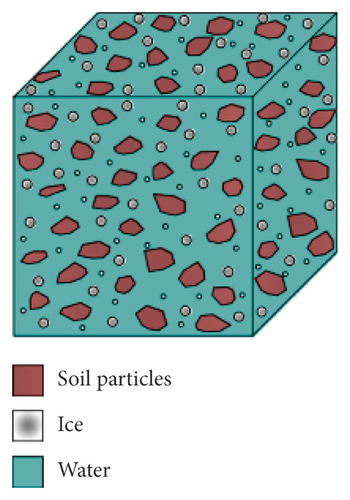
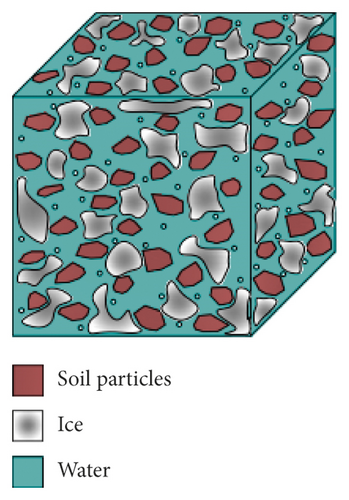
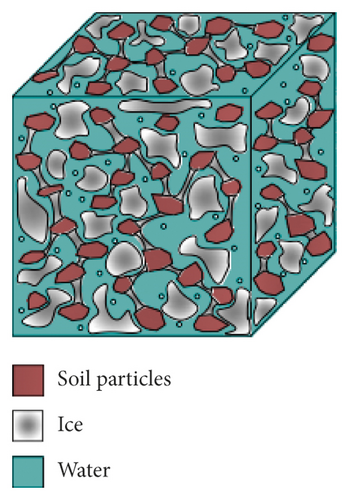
- (1)
The soil around the pile is a homogeneous and isotropic frozen saturated poroelastic medium. Based on the LCAM model established by Carcione et al. [8, 9], the medium consists of three phases: soil particles, ice, and water. This model considers the mutual contact between the solid and ice phases; however, the heat transfer in frozen saturated porous media is ignored, and the transient mutual transformation between ice and water is not considered. The bottom of the soil layer is viewed as a rigid foundation, and the top of the soil layer is regarded as a free surface.
- (2)
The pile is an elastic and homogeneous circular rod, which satisfies the one-dimensional rod theory. As the existing research pointed out, the effect of Poisson’s ratio on the vibration of pile is mainly reflected in the three-dimensional dispersion of pile in the higher frequency range, which is obviously reduced when the slenderness of the pile increases [36, 37]. In addition, the range of the Poisson ratio of piles in practical engineering is also limited, as 0.18 ∼ 0.30 in the concrete piles. For simplification, the effect of Poisson’s ratio is ignored.
- (3)
The vertical vibration of the pile-soil system represents a small deformation. The interaction between the pile and the soil involves a perfect contact, which implies that the displacements and forces of the pile-soil contact surface are continuous. The frictional force on the contact surface of the pile results from the presence of the particles and ice.
2.2. Vertically Dynamic Interaction between Pile and Soil
Based on the above basic assumptions, the vertically dynamic response of a pile embedded in a frozen saturated porous medium, with the top of the pile subjected to an arbitrary excitation force P(t), as shown in Figure 2, is investigated.

To solve this partial differential equation, the following boundary conditions and initial conditions should be satisfied.
Equations (1) to (10) constitute a set of definite solution equations of the dynamic interaction between the end-bearing pile and the frozen saturated porous medium.
3. Solution of Interaction between the Pile and Soil
3.1. Fundamental Solution of Frozen Porous Media
According to the potential expressions, the nondimensionalized expressions of the displacements and stresses are obtained under axisymmetric conditions, as shown in Appendix B.
3.2. Vertical Vibration of Pile in the Laplace Domain
3.3. Dynamic Response of Pile under Impact Load
The dynamic responses of the pile in frozen soil when the top of the pile is subjected to arbitrary impact loading are discussed in the present paper. Two types of dynamic loads, a rectangular loading pulse, and a triangular loading pulse, which are commonly encountered in practical engineering, are selected for this analysis, and they are shown in Figure 3. The nondimensional time , where t denotes the time, a denotes the radius of the pile, and ρ and μsm0 denote the density and shear modulus of the unfrozen saturated soil, respectively. τ0 and T0 represent the dimensional time and the amplitude of the loading pulse, respectively. In the following numerical analysis, τ0 = 2 and T0 = 1.
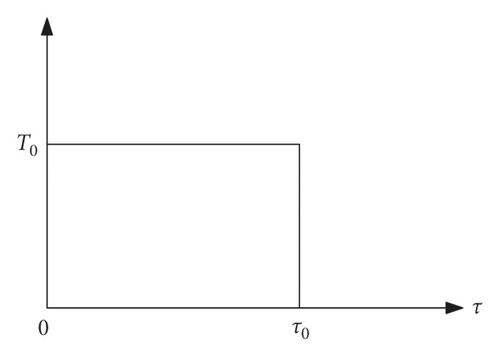
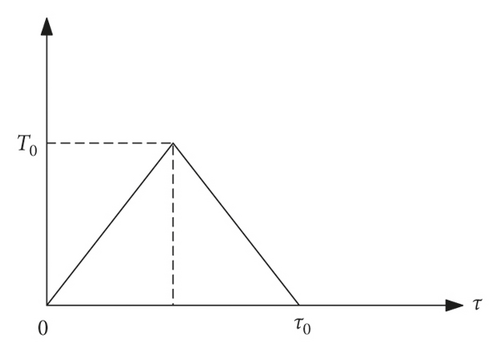
4. Numerical Results and Discussion
4.1. Material Parameters
| Grain | ρs = 2650 kg/m3 | Ks = 38.7 × 109 Pa | μs = 39.6 × 109 Pa | ks0 = 1.07 × 10−11 m2 |
| Ice | ρi = 920 kg/m3 | Ki = 8.58 × 109 Pa | μi = 3.7 × 109 Pa | ki0 = 5 × 10−4 m2 |
| Water | ρw = 1000 kg/m3 | Kw = 2.25 × 109 Pa | μw = 0 Pa | ηw = 1.798 × 10−3 Pa·s |
| Skeleton |
|
|
|
|
| Concrete pile | ρb = 2500 kg/m3 | Eb = 40.0 × 109 Pa | H = 5∼25 m | a = 0.5 m |
If the frozen soil is completely thawed, φw⟶ε and φi⟶0 are satisfied, the ice-phase parameters disappear, and the equation is reduced to that of Biot’s porous medium containing only fluid and solid phases. μsm0 is the shear modulus of unfrozen soil when the water is saturated, and its value is between 8.84 GPa and 13.1 GPa as mentioned in the abovementioned studies. It should be noted that this value is based on the elastic properties of the material itself under a very small deformation. However, according to Atkinson’s definition [39], the soil stiffness shows a three-segment line at three different strain levels, i.e., very small strain (less than 0.001%), small strain (in 0.001% to 1%), and large strain (greater than 1%). For the actual strain range of the pile vibration, the strain level of the interaction between the pile and the soil depends on the displacement caused by the pile vibration. This strain level is limited to a small strain and is much larger than the elastic strain property itself; therefore, the actual value of the shear modulus should be much smaller than the value given in the literature on the basis of the interaction between the pile and the soil [40]. A reasonable value of the small strain shear stiffness can be obtained by performing a field shear wave test or by using a bender element in a triaxial shear test or resonance column test performed in the laboratory. In this study, for convenience, the shear wave velocity of the saturated porous media after the ice has melted completely is used to estimate the shear modulus of the unfrozen soil. The specific values are listed in Table 1.
The other two parameters that are required to be explained additionally are the volumetric compressive modulus Kmax and shear modulus μmax of the ice phase. The values of Kmax and μmax provided in Leclaire’s literature are based on the Kuster and Toksoz model [41]. The expressions for Kmax and μmax are determined via equations (1) and (2) defined by Zimmerman and King [42], respectively, with the subscript m corresponding to ice, subscript i corresponding to air, and concentration c equal to φs, as defined by Carcione and Seriani [43]. Similarly, the Kuster–Toksöz modulus for the solid matrix μsmKT can also be calculated based on these equations.
Regarding the frequency of vibration in frozen porous media, Leclaire et al. described two frequency ranges, i.e., low and high frequencies. Generally, no matter what kind of excitation is applied, the frequency range of the vibration of pile foundations pertains to that lower than 2 kHz. Therefore, in the present work, the dynamic viscosity is calculated in the low-frequency range.
4.2. Verification of Numerical Results
In this section, the validity of the present method is proved by comparing the obtained solutions with the available and the degenerate solutions.
4.2.1. Verification of Degeneration
-
For the single-phase elastic medium, ρ = 1920 kg/m3, ρb = 2500 kg/m3, μ = 43.2 MPa, and ν = 0.4.
-
For the saturated porous medium, ρs = 2650 kg/m3, ρb = 2500 kg/m3, ρf = 1000 kg/m3, ε = 0.44, Ks = 38.7 GPa, Kw = 2.25 GPa, η = 1.0 × 10−3 Ns/m2, k = 1.0 × 10−10 m2, and μ = 43.2 MPa.
-
For the frozen saturated porous medium, the parameters are listed in Table 1, and for the analysis, it is assumed that rav = 0.1 μm, Δr = 0.1 μm, and r0 = 0.228 nm.
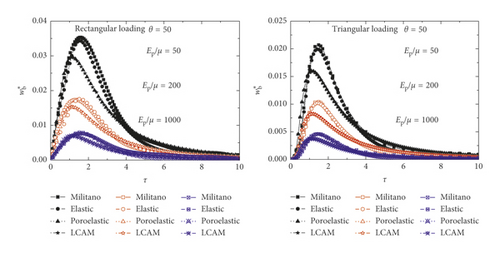


As mentioned, when the unfrozen water content is close to the porosity, that is, when the ice content is close to zero, the frozen porous medium degenerates into saturated soil. In this analysis, the temperature was set to −0.20°C, and the corresponding unfrozen water content could be calculated according to equation (36) as φw = 0.431 ≈ ε = 0.44. Therefore, the solution of a pile in the LCAM model could be compared with the solution of a pile in Biot’s porous medium. For a single-phase elastic medium, the density was set as 1920 kg/m3, which is equal to the density of saturated soil (ρ = (1 − ε)ρs + ερf = 1920 kg/m3), and the shear modulus was also equal to that for the unfrozen soil.
It can be seen from Figure 4 that for the present solution, the dynamic response under a rectangular loading pulse is notably affected by the slenderness and elastic modulus ratio of pile and soil. The time histories of the nondimensional axial displacement at the pile head for the simplified elastic model are consistent with those pertaining to Militano’s solution, and the response histories of the frozen saturated medium coincide perfectly with the solution of the saturated medium at a temperature of −0.20°C. However, the peak of the dynamic response of the pile in the frozen porous medium is lower than that of Militano’ solution due to the presence of aqueous and ice phases. Figure 4 also shows that when the slenderness is less than 30 and the elastic modulus ratio is more than 200, the differences between these solutions and Militano’s solution increase. A smaller slenderness and larger elastic modulus ratio correspond to a more pronounced difference between the time histories of these solutions. In the study of vertical vibrations of a floating pile in multilayered soils, Militano and Rajapakse [31] found that the pile response is more similar to that of an infinitely long pile when the modulus ratio of the pile-soil is greater than 500 with the slenderness equals to 10. The differences in the dynamic response of the pile increase with larger slenderness, which means that the modulus ratio of the pile and soil has major effect on a longer pile. However, such a phenomenon does not appear in the present work when studying an end-bearing pile embedded in frozen soil. When the slenderness of the pile is relatively small (θ < 10), the variation of the dynamic response at the pile head with different moduli ratios is dissimilar to the corresponding result of Militano’s solution. That is, when the elastic modulus ratio exceeds 500, the impact response gradually decreases with increase in the elastic modulus ratio, which is different to the dynamic response of the rigid pile. This indicates that the load transfer mechanism of an end-bearing pile is different from that of a floating pile. When the slenderness of a pile is relatively large, the interaction between the pile and soil is generated primarily by the friction of the pile shaft, and the dynamic responses of the two types of piles are similar. When the slenderness is relatively small, the resistance of the pile bottom plays a key role in vertically dynamic load transfer of the pile. The difference between the dynamic responses of the end-bearing pile and the floating pile is considerable because the resistance of the end-bearing pile at the pile bottom is far larger than that for the floating bearing pile. Note that the resistance of the pile bottom is affected by the modulus ratio of the pile and soil. A larger ratio of the pile-soil modulus corresponds to a larger difference in the resistance at the pile bottom. Therefore, the differences in the dimensionless axial displacement among the three end-bearing piles and Militano’s solution increase notably with increase in the modulus ratio of the pile and soil. At the same time, it can be seen from the Figure 4 that the peak value and pulse width of the pulse loading at the top of the pile under a triangular pulse are lower than the corresponding values under a rectangular pulse.
4.2.2. Comparison of LCAM Model and LCA Model
The LCAM model described by using equation (2) is a modified model of the LCA model proposed by Leclaire et al. [6]. The LCAM model considers the interaction between the soil skeleton and ice, and the LCA model can be regarded as a special case of the LCAM model. If R13, μ13, and ρ13 in equation (2) are set as zero, equation (2) is degenerated into the governing equation of the LCA model expressed by Leclaire et al. Figure 5 shows the comparisons between the time histories of a pile in LCAM and LCA mediums under rectangular and triangular loading pulses. When the temperature T = −0.2°C, the ice content is very low and the unfrozen water nearly fills the pores (φw = 0.431); the dynamic responses of the pile in the LCAM medium and LCA medium exhibit good agreement. However, when the temperature T = −0.5°C (φw = 0.229), the differences between the two cases are significant and increase with decrease in the modulus ratio between the pile and soil. This result indicates that the interaction between the soil skeleton and ice can be neglected at a lower ice content but not at a higher ice content; furthermore, the LCA model is suitable only for warm permafrost, while the LCAM model is suitable for situations having a wider temperature range.
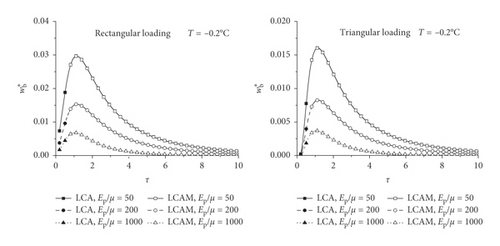
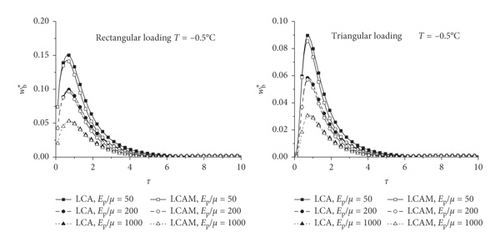
4.3. Effect of Temperature on the Vertically Dynamic Response of Pile
As seen from equation (36), the temperature has a direct effect on the content of unfrozen water in frozen soil. A lower temperature corresponds to lower content of unfrozen water and, thereby, higher ice content. The effect of temperature on the amount of unfrozen water is also closely related to some other factors such as the particle size of the grain, size, and distribution of the pores, and salt content of the pore water. Neglecting the effect of salt, the influence of temperature on the vertically dynamic response histories of the pile under the same pore distribution is analyzed, and the results are shown in Figure 6.

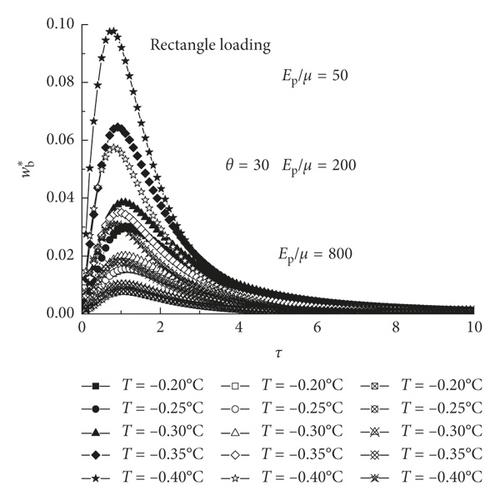
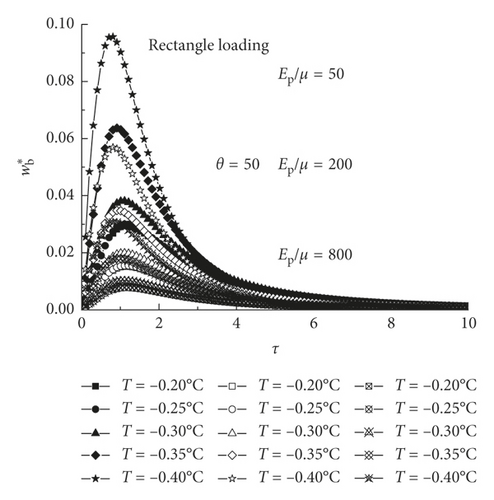
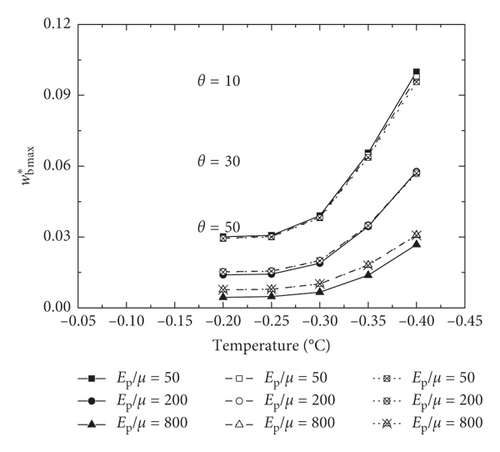
Figures 6(a)–6(c) show the effect of temperature on the time histories of nondimensional axial displacement in the time domain on the top of a pile over a certain temperature range. The temperatures are −0.20°C, −0.25°C, −0.30°C, −0.35°C, and −0.40°C, and the relevant parameters are set as rav = 0.1 μm, Δr = 0.1 μm, and r0 = 0.228 nm. According to equation (36), the unfrozen water content φw was 0.431, 0.404, 0.366, 0.326, and 0.289, respectively. The change in temperature causes the ice content to change and consequently causes a variation in the shear modulus of frozen soil. Therefore, the nondimensional axial displacement of the pile in the time domain gradually increases due to the decrease in the modulus ratio between the pile and soil. However, it is also seen from Figure 6(d) that the maximum amplitude of the axial displacement at the pile head develops nonlinearly with the temperature and the lowest value is noted at T = −0.20°C. At a temperature of −0.25°C, the curve is almost identical to the curve corresponding to −0.20°C. As the temperature further decreases, the difference increases. This phenomenon indicates that when the temperature is close to the freezing temperature, although a small amount of water in the frozen porous medium transforms to ice, an ice skeleton is not formed. Therefore, the corresponding effects on the wave propagation in frozen soil and vibration of the pile are smaller. When the temperature reaches −0.30°C, the ice content is approximately 0.074 and the slope of the curve increases slightly. When the temperature exceeds −0.3°C, the slope increases rapidly, indicating that an ice skeleton has been formed at this moment.
5. Conclusions
- (1)
Based on the LCAM model, a uniform model for the vertically dynamic response of an end-bearing pile embedded in a frozen soil layer is established, and the solution is obtained by employing Laplace transformation and variable separation in the Laplace domain. The dynamic response histories of nondimensional axial displacement under two transient loadings in the time domain are obtained by a numerical inversion transformation technique.
- (2)
The numerical results show that the solution is consistent with the vertically dynamic response of an end-bearing pile in saturated porous media when the temperature is close to the freezing temperature, indicating that the present solution is degradable.
- (3)
The axial displacement amplitude of the present solution is smaller than the amplitude of an end-bearing pile and a floating pile in a single-phase elastic medium due to the dissipation among the water, ice matrix, and solid matrix. The results also show that the dynamic load transfer mechanisms of the end-bearing pile and the floating pile are different. When the slenderness is small, the differences between the vertical dynamic displacements are notable. As the slenderness increases, this difference is gradually reduced because the influence of the pile bottom is weakened and the pile is mainly supported by the frictional resistance of the pile shaft.
- (4)
The comparisons of time histories of the pile in LCAM and LCA media under a pulse show that a significant difference exists between the LCAM model and the LCA model at low temperatures, indicating that the displacement amplitude of the LCA model is slightly overestimated.
- (5)
The temperature has a major influence on the vertically dynamic response of a pile in a frozen porous medium. As the temperature decreases, the modulus ratio between the pile and soil decreases, and consequently, the displacement response on the top of the pile gradually increases.
- (6)
The present results are not only theoretically significant for understanding the mechanism of the interaction between the pile and the soil but also have extensive application prospects in permafrost regions.
Conflicts of Interest
The authors declare that they have no conflicts of interest.
Acknowledgments
This work was supported by the Natural Science Foundation of China under grant number 51879236, the Zhejiang Provincial Natural Science Foundation of China under grant number LY15E090008, and the Key Laboratory of Geotechnical and Underground Engineering, Ministry of Education under grant number KLE-TJGE-B1502. We appreciate all institutions and individuals that have provided supports for this paper.
Appendix
A. Detailed Descriptions of Parameters in Equations (13) and (14)
B. Axisymmetric Displacements and Stresses of Frozen Saturated Porous Medium
Open Research
Data Availability
The data used to support the findings of this study are available from the corresponding author upon request.




